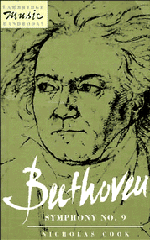Conclusion Beyond interpretation?
Published online by Cambridge University Press: 08 January 2010
Summary
Political interpretations of music substitute themselves for the original. Implicitly or explicitly, they claim to embody the work as it is, leaving no room for doubt or even for personal interpretation. And this is equally true of Wagner's and Schenker's interpretations of the Ninth Symphony. Both Wagner and Schenker lay claim to Beethoven's personal authority, justifying their interpretations by frequent reference to his intentions. In Iser's sense, Wagner and Schenker interpret the Ninth as propaganda no less than do Edgar Quinet or Liu Nai Xiong. But, of course, the very multiplicity of these interpretations undermines their claim to present the work ‘as it is’. In reality Beethoven did not write propaganda; Wagner, Schenker, Quinet, and Liu have all inserted their interpretations into the gaps in his music, so consummating, so to speak, Beethoven's symbols. This corresponds to Iser's second model of musical meaning. But from the perspective of Adorno's critique, the difference between Iser's first and second models does not count for that much. By substituting itself for the original, a dominant interpretation can turn the work into propaganda. And that is what Adorno says has happened to the Ninth Symphony.
But at this point I would like to put forward the third model of musical meaning to which I referred in chapter 5. Parsifal is a prime example of this. It is obvious that Parsifal is about compassion: the relationship between the first and last acts is precisely that Parsifal lacks this quality in the first act but has acquired it in the last.
- Type
- Chapter
- Information
- BeethovenSymphony No. 9, pp. 100 - 105Publisher: Cambridge University PressPrint publication year: 1993



